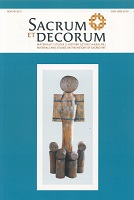Postać św. Franciszka w sztuce i myśli Jerzego Nowosielskiego. Wystrój kościoła oo. Franciszkanów-Reformatów pw. Niepokalanego Poczęcia Najświętszej Marii Panny na Azorach w Krakowie (1977–1978)
The figure of St Francis in the art and thought of Jerzy Nowosielski.
Interior of the Reformed Franciscan Church of the Immaculate Conception of Holy Virgin Mary in the neighborhood of Azory in Kraków (1977–1978)
Author(s): Krystyna CzerniContributor(s): Grażyna Ryba (Editor)
Subject(s): History, Fine Arts / Performing Arts, Theology and Religion
Published by: Wydawnictwo Uniwersytetu Rzeszowskiego
Keywords: Jerzy Nowosielski; Franciscans; contemporary icon; St Francis; Kraków; monumental painting; Stations of the Cross
Summary/Abstract: One of the most popular saints, St Francis, canonized in 1228, remains “ecumenical”, venerated also by the Eastern Orthodox Church. The saint of Assisi proved especially important for the spirituality and art of the Kraków-based avant-garde painter and Eastern Orthodox thinker, Jerzy Nowosielski, who lamented that the Western Christian consciousness had completely flattened the main ideas of the saint, reducing them to naïve sentimentality. Turning back to St Francis, the artist hoped for a renewal of Christianity and the revival of contemporary theological thought. Important elements of the Franciscan tradition in Nowosielski’s art show up in his so-called Franciscan crosses: polychrome images of the crucified Christ of the croce dipinta, croce storiata type, modeled on the San Damiano Cross. Nowosielski painted dozens of such crosses, both for liturgical purposes (to fit at the top of an iconostasis or a tetrapod), and for private devotion. The figure of St Francis also appeared several times in his monumental art: the polychromes in the churches in Olszyny (1957) and in Zbylitowska Góra (1956–1957), as well as in the mosaic entitled The Stigmatization of St Francis produced for the church in Izabelin near Warsaw (1980); these, however, have not survived to the present day. His most interesting and elaborate “Franciscan” project is the interior of the Reformed Franciscan Church of the Immaculate Conception of the Holy Virgin Mary in the neighborhood of Azory in Kraków, harking back to the canon of Reformed Franciscan churches: the Stations of the Cross and the large altarpiece. These works combined the spirituality of the icon with avant-garde esthetics; the artist also infused them with iconographic motifs from the Eastern Orthodox tradition: the Mandylion (used twice), the theme of Anastasis, the Orant, the Plashchanitsa serving as the last Station of the Cross (Jesus is laid in the tomb), and the images of the three convicts in scenes of the Passion, alluding to the Eastern Orthodox worship of the Good Thief. The multi-eyed depiction of the Seraph is rooted in an earlier, Byzantine angelological iconography; the stigmatization of St Francis, in turn, is modeled on 13th Italian iconography but also on the image of St Francis as seen in the stained-glass window produced by Stanisław Wyspiański for the Franciscan church in Kraków at the turn of the 19th and 20th century. The elaborate symbolism of the retable of Azory combined Franciscan themes with motifs of the Eucharist and the Passion, drawing profusely on the Eastern Orthodox tradition; thanks to its concise and ascetic form, as well as its audacious colors, it took on a truly monumental dimension. Św. Franciszek – jeden z najbardziej popularnych świętych, kanonizowany w 1228 roku, pozostaje świętym „ekumenicznym” – szanowanym również przez prawosławie. „Biedaczyna z Asyżu” okazał się także niezwykle ważny zarówno dla duchowości, jak i sztuki krakowskiego awangardowego malarza i prawosławnego myśliciela – Jerzego Nowosielskiego, który ubolewał, że zachodnia świadomość chrześcijańska całkowicie spłyciła główne idee świętego, sprowadzając je do naiwnego sentymentalizmu. W powrocie do idei św. Franciszka artysta upatrywał nadzieję na odrodzenie się chrześcijaństwa i ożywienie współczesnej myśli teologicznej. Jednym z ważnych śladów tradycji franciszkańskiej w sztuce Nowosielskiego są tzw. krzyże franciszkańskie – polichromowane wyobrażenia Ukrzyżowanego, typu croce dipinta, croce storiata, wzorowane na słynnym krzyżu z San Damiano. Nowosielski namalował takich krzyży kilkadziesiąt, przeznaczając je zarówno do celów liturgicznych (jako zwieńczenie ikonostasu lub tetrapodu), jak i do dewocji prywatnej. Postać św. Franciszka pojawiła się także kilkakrotnie w jego sztuce monumentalnej: polichromii kościoła w Olszynach (1957) i w Zbylitowskiej Górze (1956–1957), a także w mozaice Stygmatyzacja św. Franciszka dla kościoła w Izabelinie pod Warszawą (1980) – jednak realizacje te uległy niestety zniszczeniu. Najciekawszą i najbardziej rozbudowaną „franciszkańską” realizacją Nowosielskiego pozostaje wystrój wnętrza kościoła oo. Franciszkanów-Reformatów pw. Niepokalanego Poczęcia Najświętszej Marii Panny na Azorach w Krakowie, nawiązujący do kanonu kościołów reformackich: stacje drogi krzyżowej oraz wielkie panneau ołtarzowe. Do dzieł tych – łączących duchowość ikony z estetyką awangardy – artysta wprowadził wątki ikonograficzne charakterystyczne dla tradycji wschodniej: dwukrotnie użyty motyw mandylionu, temat Anastazis, motyw Orantki, formę Płaszczanicy jako ostatnią stację drogi krzyżowej (Złożenia do grobu) oraz wizerunki trzech skazańców w scenach pasyjnych, odwołujące się do żywego w prawosławiu kultu św. Łotra. Również przedstawienie wielookiego Serafina zdradza wpływ wcześniejszej, bizantyńskiej ikonografii angelologicznej, z kolei interpretacja stygmatyzacji św. Franciszka nawiązuje do trzynastowiecznej ikonografii włoskiej, ale także do wizerunku św. Franciszka z witrażu Stanisława Wyspiańskiego z przełomu wieków XIX i XX w krakowskim kościele Franciszkanów. Rozbudowana symbolika retabulum z Azorów, łącząca wątki franciszkańskie, eucharystyczne i pasyjne, oraz czerpiąca wiele wątków z tradycji prawosławnej zyskała w interpretacji krakowskiego malarza – dzięki lapidarności ascetycznej formy i odważnej kolorystyce – charakter monumentalny.
Journal: Sacrum et Decorum. Materiały i studia z historii sztuki sakralnej
- Issue Year: 2015
- Issue No: 8
- Page Range: 73-105
- Page Count: 33
- Language: English, Polish

